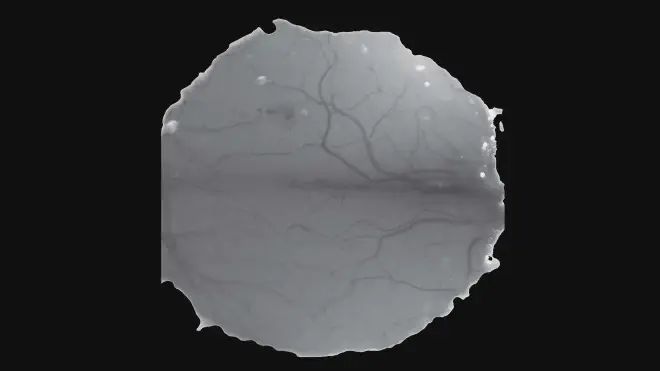A hearing aid for… your nose?
Table of Contents

Kaboom!
The first time most of us hear the sound of an explosion is in the movies. Encountering the sound in the real world—even at a distance—has a profoundly different effect. Why? It’s all about context. How we react to sounds and other sensory stimuli depends on how they’re presented. We often don’t know how we’ll respond to something until we experience it. And the sensation is sometimes quite different from what we expected. So, the brain has to adjust quickly.

Cold Spring Harbor Laboratory (CSHL) Professor Florin Albeanu explains: “In nature, animals are faced with different rules of engagement. Sometimes, the same stimuli mean different things depending on context. Therefore, it’s not so unusual that you have to act on these different rules and assess what action you have to take. What are the associations that the stimulus has with certain outcomes?”
New research from Albeanu and postdoc Diego Hernandez Trejo helps explain how this works. Their findings point to never-before-seen fast-updating signals in a feedback loop between the brain’s olfactory cortex and olfactory bulb. These signals may help put odors and sounds into new contexts. The feedback loop may enable an animal’s brain to immediately adapt to changes and help the animal fine-tune its motor responses accordingly.
This short film shows how odor information might travel through your brain when you smell something.
Hernandez Trejo and colleagues ran a series of behavioral tests to measure mice’s reactions to different smells and sounds. **The mice were trained to associate rewards with one stimulus but not the other—and only for a while. Importantly, the researchers switched the rules once the mice seemed to learn them. That presented little trouble for expert mice, Albeanu says.

“The animal is able to extract this change. Within a few seconds, it’s going to act in a way that is consistent with understanding. Interestingly, we observed that top-down signals, which originate in the olfactory cortex, convey information about the reward value of the stimulus to the olfactory bulb—irrespective of them being sound or odor.”
The olfactory cortex is the part of the brain that processes smell, yet it seems to take sound into account. This result tracks with another CSHL discovery, which shows how sensory cues become integrated with each other in the brain. It also raises some exciting questions.
-
How do reward signals emerge?
-
Does this feedback loop also integrate sight and touch?
“There’s a universe of possibilities,” Albeanu says. He’s eager to continue exploring that universe along with collaborators Andrei Ciuparu and Raul Muresan from TINS in Romania, knowing that each answer tells us more about the world we share and the perceptions that shape our understanding of it.
-
Core Facilites “The Animal Shared Resource houses and cares for the animals essential for scientific research. Our staff perform all aspects of animal husbandry, ensure humane care, and assist researchers with highly technical procedures and protocol design and development.” — Animal Facility Director and Attending Veterinarian Rachel Rubino, DVM
-
Funding: National Science Foundation, National Institutes of Health, CIRCUITGENUS, NEUROTWIN, European Research Area Network, Romanian National Authority for Scientific Research and Innovation
-
The paper “Fast updating feedback from piriform cortex to the olfactory bulb relays multimodal identity and reward contingency signals during rule-reversal”, Hernandez Trejo, D.E., et al., was published in Nature Communications January 22, 2025. DOI: 10.1038/s41467-025-56023-5
-
The article A hearing aid for… your nose?, written by Nick Wurm, Communications Specialist | wurm@cshl.edu | 516-367-5940, was published in Cold Spring Harbor Laboratory’s site.
Versión en español #
¿Un audífono para… tu nariz? #
Kaboom!
La primera vez que la mayoría de nosotros escuchamos el sonido de una explosión es en las películas. Encontrarse con el sonido en el mundo real, incluso a distancia, tiene un efecto profundamente diferente. ¿Por qué? Todo es cuestión de contexto. Nuestra reacción a los sonidos y otros estímulos sensoriales depende de cómo se presentan. A menudo no sabemos cómo responderemos a algo hasta que lo experimentamos. Y la sensación a veces es bastante diferente de lo que esperábamos. Por lo tanto, el cerebro tiene que adaptarse rápidamente.

El profesor Florin Albeanu del Laboratorio Cold Spring Harbor (CSHL) explicó que “en la naturaleza, los animales se enfrentan a diferentes reglas de interacción. A veces, los mismos estímulos significan cosas diferentes según el contexto. Por lo tanto, no es tan inusual que tengas que actuar según estas diferentes reglas y evaluar qué acción debes tomar. ¿Qué asociaciones tiene el estímulo con determinados resultados?
Una nueva investigación de Albeanu y el investigador posdoctoral Diego Hernández Trejo ayuda a explicar cómo funciona esto. Sus hallazgos apuntan a señales de actualización rápida nunca antes vistas en un circuito de retroalimentación entre la corteza olfativa y el bulbo olfatorio del cerebro. Estas señales pueden ayudar a poner los olores y los sonidos en nuevos contextos. El circuito de retroalimentación puede permitir que el cerebro de un animal se adapte inmediatamente a los cambios y ayude al animal a afinar sus respuestas motoras en consecuencia.
Este cortometraje muestra cómo la información olfativa puede viajar a través de tu cerebro cuando hueles algo.
Hernández Trejo y sus colegas realizaron una serie de pruebas de comportamiento para medir las reacciones de los ratones a diferentes olores y sonidos. Los ratones fueron entrenados para asociar las recompensas con un estímulo pero no con el otro, y sólo por un tiempo. Es importante destacar que los investigadores cambiaron las reglas una vez que los ratones parecieron aprenderlas. Esto presentó pocos problemas para los ratones expertos, dijo Albeanu.
Dinu Florin Albeanu. Profesor Doctorado, Universidad de Harvard, 2008Dinu Florin Albeanu. Profesor Doctorado, Universidad de Harvard, 2008
“El animal es capaz de interpretar este cambio y, en unos pocos segundos, actuará de una manera coherente con su comprensión. Curiosamente, observamos que las señales descendentes, que se originan en la corteza olfativa, transmiten información sobre el valor de recompensa del estímulo al bulbo olfativo, independientemente de que se trate de un sonido o de un olor”, añadió Albeanu.
La corteza olfativa es la parte del cerebro que procesa el olor, aunque también parece tener en cuenta el sonido. Este resultado coincide con otro descubrimiento de CSHL, que muestra cómo las señales sensoriales se integran entre sí en el cerebro. También plantea algunas preguntas interesantes.
¿Cómo surgen las señales de recompensa? ¿Este circuito de retroalimentación también integra la vista y el tacto? “Hay un universo de posibilidades”, dijo Albeanu. Quien está ansioso por seguir explorando ese universo junto con sus colaboradores Andrei Ciuparu y Raul Muresan de TINS en Rumania, sabiendo que cada respuesta nos dice más sobre el mundo que compartimos y las percepciones que dan forma a nuestra comprensión de él.
Cor Facilites: “El centro de recursos compartidos para animales alberga y cuida a los animales esenciales para la investigación científica. Nuestro personal se encarga de todos los aspectos de la cría de animales, garantiza una atención humanitaria y ayuda a los investigadores con procedimientos altamente técnicos y diseño y desarrollo de protocolos”. — Directora de instalaciones para animales y veterinaria asistente Rachel Rubino, DVM
-
Financiamiento: National Science Foundation, National Institutes of Health, CIRCUITGENUS, NEUROTWIN, European Research Area Network, Romanian National Authority for Scientific Research and Innovation
-
El paper “Fast updating feedback from piriform cortex to the olfactory bulb relays multimodal identity and reward contingency signals during rule-reversal”, Hernandez Trejo, D.E., et al., fue publicado en Nature Communications January 22, 2025. DOI: 10.1038/s41467-025-56023-5
-
El artículo A hearing aid for… your nose?, escrito por by Nick Wurm, Communications Specialist | wurm@cshl.edu | 516-367-5940, fue publicado en el sitio de Cold Spring Harbor Laboratory.


